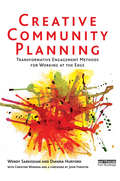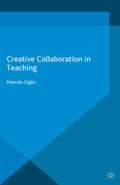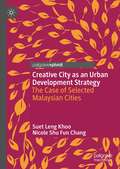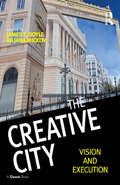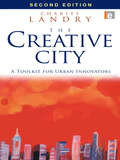- Table View
- List View
Creative Involvement: A New Direction in China's Diplomacy (China Perspectives)
by Yizhou WangWith the enhancement of national strength, China’s diplomacy has leapt onto a new high ground, basically obtaining the status of a world power. Meanwhile, it has also received a large amount of right and wrong mixed criticism and suggestions from different sides, in the face of a sudden increase in opportunities, pressures, and conflicts. The "creative involvement" in this book is exactly proposed for the future of China’s diplomacy. In this book, the author first defines the concept "creative involvement". Different from diplomatic theories in the traditional senses, creative involvement is a kind of diplomatic thinking which encourages more active participation in international affairs and advocates creative solutions. Then the author makes case studies on some events and people which have been of typical significance in China’s diplomatic practices since the end of the Cold War, expounding their innovations and limitations. In the third part, the author turns to various supportive propositions, ideas, and theories concerning creative involvement and explains how they are applied to China’s future diplomatic practice. Lastly, the author tries to set a number of scenarios, discussing the possible entry points for creative involvement. Combining innovative theoretical idea with practical investigation, this book will not only contribute to contemporary China diplomatic studies but also appeal to scholars and students of international relations studies.
Creative Involvement: The Evolution of China's Global Role (China Perspectives)
by Yizhou WangThis book continues the "creative involvement" proposition put forward in Creative Involvement: A New Direction in China's Diplomacy with new cases and stories to enrich its content. It discusses China's global role, and explores its root cause of formation, development stages, and future direction. The main conclusion is that this role is preliminary and incomplete and needs continuous learning and improvement; China standing on the global high ground needs not only hard power but also wisdom and creativity. On research methods and writing approach, firstly, this book follows the philosophy of "practice first", namely, starting from historical experiences, focusing on practical issues, and exploring objectives and clues through case studies. Secondly, the three parts in the book have different sub-themes, but they are subject to the same thinking, that is, how does China advance toward a central role from the marginal edge of contemporary international system, how to develop doctrines or practices for China’s involvement in world affairs, and how to borrow the experiences of others to help China move forward on the global high ground. Combing innovative theoretical idea with practical investigation, this book will not only contribute to contemporary China Diplomatic studies but also appeal to scholars and students of International Relation studies. People who are interested in the rise of China and global governance will also benefit from this book.
Creative Industry Districts: An Analysis of Dynamics, Networks and Implications on Creative Clusters in Shanghai (Advances in Asian Human-Environmental Research)
by Jinliao HeSince the late 1990s, there have been broad discussions concerning the rapid rise of the creative economy. Creative or cultural industry is seen as the new engine of the regional growth for both developed economies and emerging nations. At the point of transition in economy and society, China is recently striving to transform its economy from “made in China” towards “created in China”. This book provides an insight into creative industries and spaces in Shanghai, which is the fastest growing megacity in China and the center of modern economic development on a global scale. Underpinned by new approaches from economic geography and urban studies, it deals with the new relations between the creative economy and urban environment in Shanghai. Over the last decade, creative clusters have been rapidly emerging in particular locations in the central city of Shanghai. This spatial phenomenon is explained in the book through an analysis of dynamics, networks and implications.
Creative Governance: Opportunities for Fisheries in Europe (Routledge Revivals)
by Jan Kooiman, Martijn Van Vliet and Svein JentoftPublished in 1999, Creative Governance sets out to develop new ideas on the development of Fisheries in Europe. The scholarly and political attention for fisheries in general within Europe is predominantly focused on problems of controlling catch. In this book it is not the problems of harvesting which are taken as the starting point, but opportunities in fisheries as a whole: catch, processing, market and consumption of fish and fish products. The discussion is broadened to include the management of fisheries from the perspective of governance rather than management or policy. Governance is a new and important concept currently being developed in several areas of social science, in this book the governance concept is related to the creation of new opportunities of fisheries in Europe. The combination of these two approaches is not only important for fisheries (in Europe) but also to the governance of natural resources more generally where the shift from a problem to an opportunity and from a management or a governance approach might shed new light and stimulate new actions. The book is the product of close cooperation between scholars from biological, geographical, political science, management studies and anthropological backgrounds.
Creative Governance: Opportunities for Fisheries in Europe (Routledge Revivals)
by Jan Kooiman Martijn Van Vliet Svein JentoftPublished in 1999, Creative Governance sets out to develop new ideas on the development of Fisheries in Europe. The scholarly and political attention for fisheries in general within Europe is predominantly focused on problems of controlling catch. In this book it is not the problems of harvesting which are taken as the starting point, but opportunities in fisheries as a whole: catch, processing, market and consumption of fish and fish products. The discussion is broadened to include the management of fisheries from the perspective of governance rather than management or policy. Governance is a new and important concept currently being developed in several areas of social science, in this book the governance concept is related to the creation of new opportunities of fisheries in Europe. The combination of these two approaches is not only important for fisheries (in Europe) but also to the governance of natural resources more generally where the shift from a problem to an opportunity and from a management or a governance approach might shed new light and stimulate new actions. The book is the product of close cooperation between scholars from biological, geographical, political science, management studies and anthropological backgrounds.
Creative Globalization
by Stéphane CallensThe purpose of this book is to draw up a picture of the transformations in the innovation systems induced by globalization - or globalization. We understand the latter as the existence of new macroeconomic solidarities. These are attested since about the middle of the 1980s, with the observation of a tripolar world drawn up by Kenichi Ohmae. The book intends to explain all theories of globalization, as well as to clarify its relations with innovation. It constitutes an unprecedented synthesis on this theme, illustrated by examples from many sectors of activity.
Creative Globalization
by Stéphane CallensThe purpose of this book is to draw up a picture of the transformations in the innovation systems induced by globalization - or globalization. We understand the latter as the existence of new macroeconomic solidarities. These are attested since about the middle of the 1980s, with the observation of a tripolar world drawn up by Kenichi Ohmae. The book intends to explain all theories of globalization, as well as to clarify its relations with innovation. It constitutes an unprecedented synthesis on this theme, illustrated by examples from many sectors of activity.
Creative Economies, Creative Cities: Asian-European Perspectives (GeoJournal Library #98)
by Lily Kong Justin O'ConnorJustin O’Connor and Lily Kong The cultural and creative industries have become increasingly prominent in many policy agendas in recent years. Not only have governments identified the growing consumer potential for cultural/creative industry products in the home market, they have also seen the creative industry agenda as central to the growth of external m- kets. This agenda stresses creativity, innovation, small business growth, and access to global markets – all central to a wider agenda of moving from cheap manufacture towards high value-added products and services. The increasing importance of cultural and creative industries in national and city policy agendas is evident in Hong Kong, Singapore, Taiwan, South Korea, Beijing, Shanghai and Guangzhou, Australia, and New Zealand, and in more nascent ways in cities such as Chongqing and Wuhan. Much of the thinking in these cities/ countries has derived from the European and North American policy landscape. Policy debate in Europe and North America has been marked by ambiguities and tensions around the connections between cultural and economic policy which the creative industry agenda posits. These become more marked because the key dr- ers of the creative economy are the larger metropolitan areas, so that cultural and economic policy also then intersect with urban planning, policy and governance.
The Creative Destruction of New York City: Engineering the City for the Elite
by Alessandro BusàBill de Blasio's campaign rhetoric focused on a tale of two cities: rich and poor New York. He promised to value the needs of poor and working-class New Yorkers, making city government work better for everyone-not just those who thrived during Bloomberg's tenure as mayor. But well into de Blasio's administration, many critics think that little has changed in the lives of struggling New Yorkers, and that the gentrification of New York City is expanding at a record pace across the five boroughs. Despite the mayor's goal of creating more affordable housing, Brooklyn and Manhattan sit atop the list of the most unaffordable housing markets in the country. It seems that the old adage is becoming truer: New York is a place for only the very rich and the very poor. In The Creative Destruction of New York City, urban scholar Alessandro Busà travels to neighborhoods across the city, from Harlem to Coney Island, from Hell's Kitchen to East New York, to tell the story of fifteen years of drastic rezoning and rebranding, updating the tale of two New Yorks. There is a gilded city of sky-high glass towers where Wall Street managers and foreign billionaires live-or merely store their cash. And there is another New York: a place where even the professional middle class is one rent hike away from displacement. Despite de Blasio's rhetoric, the trajectory since Bloomberg has been remarkably consistent. New York's urban development is changing to meet the consumption demands of the very rich, and real estate moguls' power has never been greater. Major players in real estate, banking, and finance have worked to ensure that, regardless of changes in leadership, their interests are safeguarded at City Hall. The Creative Destruction of New York City is an important chronicle of both the success of the city's elite and of efforts to counter the city's march toward a glossy and exclusionary urban landscape. It is essential reading for everyone who cares about affordable housing access and, indeed, the soul of New York City.
The Creative Destruction of New York City: Engineering the City for the Elite
by Alessandro BusàBill de Blasio's campaign rhetoric focused on a tale of two cities: rich and poor New York. He promised to value the needs of poor and working-class New Yorkers, making city government work better for everyone-not just those who thrived during Bloomberg's tenure as mayor. But well into de Blasio's administration, many critics think that little has changed in the lives of struggling New Yorkers, and that the gentrification of New York City is expanding at a record pace across the five boroughs. Despite the mayor's goal of creating more affordable housing, Brooklyn and Manhattan sit atop the list of the most unaffordable housing markets in the country. It seems that the old adage is becoming truer: New York is a place for only the very rich and the very poor. In The Creative Destruction of New York City, urban scholar Alessandro Busà travels to neighborhoods across the city, from Harlem to Coney Island, from Hell's Kitchen to East New York, to tell the story of fifteen years of drastic rezoning and rebranding, updating the tale of two New Yorks. There is a gilded city of sky-high glass towers where Wall Street managers and foreign billionaires live-or merely store their cash. And there is another New York: a place where even the professional middle class is one rent hike away from displacement. Despite de Blasio's rhetoric, the trajectory since Bloomberg has been remarkably consistent. New York's urban development is changing to meet the consumption demands of the very rich, and real estate moguls' power has never been greater. Major players in real estate, banking, and finance have worked to ensure that, regardless of changes in leadership, their interests are safeguarded at City Hall. The Creative Destruction of New York City is an important chronicle of both the success of the city's elite and of efforts to counter the city's march toward a glossy and exclusionary urban landscape. It is essential reading for everyone who cares about affordable housing access and, indeed, the soul of New York City.
Creative Destruction?: Economic Crises and Democracy in Latin America
by Francisco E. GonzálezThroughout the twentieth century, financial shocks toppled democratic and authoritarian regimes across Latin America. But things began to change in the 1980s. This volume explains why this was the case in Argentina, Chile, and Uruguay.Taking a comparative historical approach, Francisco E. González looks at how the Great Depression, Latin America’s 1980s debt crisis, and the emerging markets' meltdowns of the late 1990s and early 2000s affected the governments of these three Southern Cone states. He finds that democratic or not, each nation’s governing regime gained stability in the 1980s from a combination of changes in the structure and functioning of national and international institutions, material interests, political ideologies, and economic paradigms and policies. Underlying these changes was a growing ease in the exchange of ideas. As the world’s balance of power transitioned from trilateral to bipolar to unipolar, international institutions such as the World Bank and the International Monetary Fund increased crisis interventions that backstopped economic freefalls and strengthened incumbents. Urban-based populations with relatively high per capita income grew and exercised their preference for the stability and prosperity they found as a class under democratic rule. These and other factors combined to substantially increase the cost of military takeovers, leading to fewer coups and an atmosphere friendlier toward domestic and foreign capital investment. González argues that this confluence created a pro-democracy bias—which was present even in Augusto Pinochet’s Chile—that not only aided the states’ ability to manage economic and political crises but also lessened the political, social, and monetary barriers to maintaining or even establishing democratic governance. With a concluding chapter on the impact of the Great Recession in other Latin American states, Eastern Europe, and East Asia, Creative Destruction? lends insight into the survival of democratic and authoritarian regimes during times of extreme financial instability. Scholars and students of Latin America, political economy, and democratization studies will find González's arguments engaging and the framework he built for this study especially useful in their own work.
Creative Destruction?: Economic Crises and Democracy in Latin America
by Francisco E. GonzálezThroughout the twentieth century, financial shocks toppled democratic and authoritarian regimes across Latin America. But things began to change in the 1980s. This volume explains why this was the case in Argentina, Chile, and Uruguay.Taking a comparative historical approach, Francisco E. González looks at how the Great Depression, Latin America’s 1980s debt crisis, and the emerging markets' meltdowns of the late 1990s and early 2000s affected the governments of these three Southern Cone states. He finds that democratic or not, each nation’s governing regime gained stability in the 1980s from a combination of changes in the structure and functioning of national and international institutions, material interests, political ideologies, and economic paradigms and policies. Underlying these changes was a growing ease in the exchange of ideas. As the world’s balance of power transitioned from trilateral to bipolar to unipolar, international institutions such as the World Bank and the International Monetary Fund increased crisis interventions that backstopped economic freefalls and strengthened incumbents. Urban-based populations with relatively high per capita income grew and exercised their preference for the stability and prosperity they found as a class under democratic rule. These and other factors combined to substantially increase the cost of military takeovers, leading to fewer coups and an atmosphere friendlier toward domestic and foreign capital investment. González argues that this confluence created a pro-democracy bias—which was present even in Augusto Pinochet’s Chile—that not only aided the states’ ability to manage economic and political crises but also lessened the political, social, and monetary barriers to maintaining or even establishing democratic governance. With a concluding chapter on the impact of the Great Recession in other Latin American states, Eastern Europe, and East Asia, Creative Destruction? lends insight into the survival of democratic and authoritarian regimes during times of extreme financial instability. Scholars and students of Latin America, political economy, and democratization studies will find González's arguments engaging and the framework he built for this study especially useful in their own work.
Creative destruction: How to start an economic renaissance
by Phil MullanWestern economies have become stuck in a protracted depression that began long before the 2008 crash. Low productivity, which started in the 1970s, has prevented durable rises in living standards. Phil Mullan shows that the only way to ensure a better future is to create one, calling for a comprehensive economic restructure backed by political and cultural change. This means embracing the uncomfortable disruption involved in progressive change, rekindling in democratic form a spirit of Enlightenment thinking. The votes for Brexit and in the US presidential elections in 2016 indicate that many people desire change, offering greater opportunity for this public discussion. What is needed is a new industrial revolution which develops a broad range of emerging and yet unimagined services and products, provides decent jobs and restores prosperity. Providing examples of the new technologies needed to drive change, backed up by a wealth of data, this important book calls for a sea-change in imagination and thinking.
Creative destruction: How to start an economic renaissance
by Phil MullanWestern economies have become stuck in a protracted depression that began long before the 2008 crash. Low productivity, which started in the 1970s, has prevented durable rises in living standards. Phil Mullan shows that the only way to ensure a better future is to create one, calling for a comprehensive economic restructure backed by political and cultural change. This means embracing the uncomfortable disruption involved in progressive change, rekindling in democratic form a spirit of Enlightenment thinking. The votes for Brexit and in the US presidential elections in 2016 indicate that many people desire change, offering greater opportunity for this public discussion. What is needed is a new industrial revolution which develops a broad range of emerging and yet unimagined services and products, provides decent jobs and restores prosperity. Providing examples of the new technologies needed to drive change, backed up by a wealth of data, this important book calls for a sea-change in imagination and thinking.
Creative Crisis in Democracy and Economy
by George C. Bitros Anastasios D KarayiannisDevelopments across the millennia suggest that, even though democracies and free market economies are continuously challenged by crises and disturbances, such as natural disasters, wars, or technological revolutions, in the countries where they take roots civil liberties deepen and per capita prosperity increases. To substantiate this claim analytically, the authors emphasize the principles that make free markets a sine qua non condition for democracy and study the nature of the relationship between free market institutions and economic growth. By examining the operating principles, outcomes and challenges experienced by contemporary democracies, many lessons are drawn with regard to how governments should act in order to avoid the pitfalls inherently associated with representative democracy. To illustrate the dangers of deviating from these principles, the authors apply their findings to the Greek democracy and economy since the Second World War.
Creative Context: Creativity and Innovation in the Media and Cultural Industries (Creative Economy)
by Nissim Otmazgin Eyal Ben-AriThe purpose of this volume is to broaden scholars' analytical perspective by placing the creative industries in frameworks that compare and contrast them with other kinds of entities, organizations, and social forms that mix creativity and production. In other words, this volume aims to set out an emerging agenda for the study of creativity in the cultural and media industries. Although this work focuses on the media and cultural industries, they are investigated in the context of other groups and organizations connecting forms of creativity with an explicit emphasis on turning ideas into concrete practices and products. The originality of this book lies in (1) presenting a comparative and interdisciplinary perspective that develops a new framework and analytical concepts to understand the notion of creativity in the media and cultural industries, and (2) providing a series of fresh empirically based studies of the process of creativity in fields such as advertising, fashion, animation, and pop culture. This comparative move is taken in order to generate new insights about the particular features of the creative industries and new questions for future analysis.
Creative Community Planning: Transformative Engagement Methods for Working at the Edge
by Wendy Sarkissian Christine WenmanCreative Community Planning provides clear access to emerging innovations in artistic, narrative, embodied and technological methods. Reflecting on the wide continuum of participatory practice, the authors explore the frontiers of community engagement within a fresh sustainability framework. Leading planning theorists, researchers and practitioners in the field reflect with the authors on the many successes and challenges in engaging with a diversity of people in rural and urban communities. These conversations reveal creativity as key to enhancing existing engagement practices. Concepts and practical applications thread through the book, including community visioning, participatory research and reporting, conflict resolution, poetry and planning language, theatre, photography, film and websites.
Creative Community Planning: Transformative Engagement Methods for Working at the Edge (Earthscan Tools For Community Planning Ser.)
by Wendy Sarkissian Christine WenmanCreative Community Planning provides clear access to emerging innovations in artistic, narrative, embodied and technological methods. Reflecting on the wide continuum of participatory practice, the authors explore the frontiers of community engagement within a fresh sustainability framework. Leading planning theorists, researchers and practitioners in the field reflect with the authors on the many successes and challenges in engaging with a diversity of people in rural and urban communities. These conversations reveal creativity as key to enhancing existing engagement practices. Concepts and practical applications thread through the book, including community visioning, participatory research and reporting, conflict resolution, poetry and planning language, theatre, photography, film and websites.
Creative Collaboration in Teaching (Palgrave Studies in Creativity and Culture)
by Marcelo GiglioCreative Collaboration in Teaching focuses on the question of how best to facilitate creative collaboration among students in the classroom setting—with a focus on music composition and from the perspective of social-cultural psychology. This book is comprehensive, cutting-edge and scholarly in its approach. Marcelo Giglio’s attention to music and creativity is detailed enough to satisfy any researcher, educator or teacher educator; but at the same time, his research approach, classroom observations and overriding recommendations can be easily applied to a wide range of subject areas. Giglio combines a rigorous review of the relevant literatures on creativity and social interactions with the reporting and analysis of his own original data across the world, and then goes on to support this important work with detailed descriptions of classroom episodes—student-to-student and teacher-to-student interactions. By combining these three elements, this book offers socio-creative and pedagogical models for education in practice as well as teacher education and research.
Creative City as an Urban Development Strategy: The Case of Selected Malaysian Cities
by Suet Leng Khoo Nicole Shu ChangThis book is a pioneering work to position the creative city concept within Malaysian urban development discourse. The chapters are written and systematically sequenced to be all-encompassing and comprehensible to audiences both from the academic and non-academic realms. The nascency of creative city development in Malaysia has motivated the timely exploration of the viability of this strategy for selected Malaysian cities (i.e. Kuala Lumpur, George Town, Ipoh, Johor Bahru). The book also discusses the global discourse on creative city and its critiques. This is followed by an overview of Malaysia’s macrolevel socio-economic and political structures as well as national policies to frame the Malaysian creative city narrative. The case study chapters are novel, as each Malaysian city unravels its unique experiences and dissects the way the city responds to the creative city agenda amidst local nuances and idiosyncrasies.
The Creative City: Vision and Execution
by James E. Doyle Biljana MickovThe Creative City: Vision and Execution, edited by James E. Doyle and Biljana Mickov, challenges the popular understanding of the Creative City, by bridging the gap between the Creative City as concept and the Creative City as practice and, in so doing, provides a contemporary template for policy makers, city planners, and citizens alike. The book will offer researchers and pragmatists a series of real-life examples of successful cultural and creative practice throughout Europe, reflecting on the analysis and thinking that forms our contemporary understanding of the creative city. It will examine and explain the changes to the concept of the ’creative city’, explore its connectivity to the cultural sector as well as other sectors and practices across Europe and will serve to illustrate the perspectives of Cultural Managers, Educators, Professionals and Researchers from the creative sector in Dublin and Europe. This book will present the reader, and the cultural sector at large, with a new reality based on the quality of contemporary creative practice. Doyle and Mickov address cultural trends such as sustainability and social networking and how they value-impact our attitudes towards culture and the creative city By recognizing that we live in a time of rapid change, which affects all systems, financial models, resources, the economy and technology, we also recognize that the creative process is at the heart of our responses to these changes.
The Creative City: Vision and Execution
by James E. Doyle Biljana MickovThe Creative City: Vision and Execution, edited by James E. Doyle and Biljana Mickov, challenges the popular understanding of the Creative City, by bridging the gap between the Creative City as concept and the Creative City as practice and, in so doing, provides a contemporary template for policy makers, city planners, and citizens alike. The book will offer researchers and pragmatists a series of real-life examples of successful cultural and creative practice throughout Europe, reflecting on the analysis and thinking that forms our contemporary understanding of the creative city. It will examine and explain the changes to the concept of the ’creative city’, explore its connectivity to the cultural sector as well as other sectors and practices across Europe and will serve to illustrate the perspectives of Cultural Managers, Educators, Professionals and Researchers from the creative sector in Dublin and Europe. This book will present the reader, and the cultural sector at large, with a new reality based on the quality of contemporary creative practice. Doyle and Mickov address cultural trends such as sustainability and social networking and how they value-impact our attitudes towards culture and the creative city By recognizing that we live in a time of rapid change, which affects all systems, financial models, resources, the economy and technology, we also recognize that the creative process is at the heart of our responses to these changes.
The Creative City: A Toolkit for Urban Innovators
by Charles LandryThe Creative City is a clarion call for imaginative action in developing and running urban life. It shows how to think, plan and act creatively in addressing urban issues, with remarkable examples of innovation and regeneration from around the world. This revised edition of Charles Landry's highly influential text has been updated with a new, extensive overview.
The Creative City: A Toolkit for Urban Innovators
by Charles LandryThe Creative City is a clarion call for imaginative action in developing and running urban life. It shows how to think, plan and act creatively in addressing urban issues, with remarkable examples of innovation and regeneration from around the world. This revised edition of Charles Landry's highly influential text has been updated with a new, extensive overview.
The creative citizen unbound: How social media and DIY culture contribute to democracy, communities and the creative economy (Connected Communities)
by Ian Hargreaves John HartleyThe creative citizen unbound introduces the concept of ‘creative citizenship’ to explore the potential of civic-minded creative individuals in the era of social media and in the context of an expanding creative economy. Drawing on the findings of a 30-month study of communities supported by the UK research funding councils, multidisciplinary contributors examine the value and nature of creative citizenship, not only in terms of its contribution to civic life and social capital but also to more contested notions of value, both economic and cultural. This original book will be beneficial to researchers and students across a range of disciplines including media and communication, political science, economics, planning and economic geography, and the creative and performing arts.












